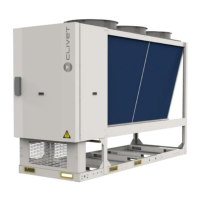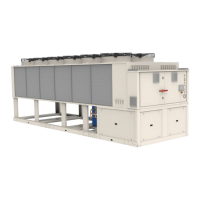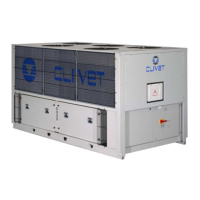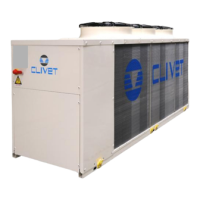Do you have a question about the CLIVET WSAN-YES 25.2 and is the answer not in the manual?
Explains manual's purpose, intended use, and installation guidelines.
Details qualified personnel requirements and mitigation of operational risks.
Covers installation, breakdown handling, modifications, and user training.
Information on serial numbers, refrigerant type, and data updating.
Procedures for checking unit condition and storing guidelines.
Guidelines for safe unit handling and packaging removal.
Considerations for unit placement, functional spaces, and airflow.
Methods for vibration transmission control and condensate disposal.
Details on optional protection grilles and anti-vibration mounts.
Guidelines for pipe design, water quality, and freeze protection.
Water flow limits, filter use, and domestic hot water system setup.
Schematics for unit connections and modular configuration.
Options for modular units and spacer installation procedures.
Line characteristics, protection devices, and personnel qualifications.
Guidelines for cable connections, signal lines, and remote ON-OFF.
Overview of customer connections and wiring diagrams.
Setting up modular systems, network configuration, and unit addressing.
Modbus communication specs, unit addressing, and register overview.
Detailed Modbus registers, functions, and error code mappings.
Essential checks, refrigerant/water circuit verification, and start-up sequence.
Verification of electrical circuits, heaters, and evaporator flow rate.
Considerations for pressure drops, compressor rotation, and reduced load operation.
Start-up sequence logic for cooling and heating in modular units.
Explanation of control panel buttons and menu navigation.
Meaning of icons for operating modes, timers, and alarms.
Accessing and configuring settings like mode, temperature, timer, and DHW.
Configuration of double setpoint, temperature compensation, and auxiliary heater.
Procedures for alarm reset, unit protection conditions, and sensor faults.
Troubleshooting communication errors, phase sequence, and flow issues.
Diagnosing errors related to pressure, temperature, modules, and antifreeze.
Interpreting unit status displays and detailed error code meanings.
General safety warnings, refrigerant handling, leak detection, and recovery.
Periodic inspection tasks for exchangers, filters, pumps, and fans.
Steps for draining the system and preparing for standby mode.
Procedures for unit disconnection and avoiding environmental spills.
Guidelines for the proper disposal of electrical and electronic equipment.
Identifying common risks from handling, installation, and general operation.
Risks associated with electrical components, refrigerant, and moving parts.
Detailed dimensional drawings for unit sizes 18.2 and 20.2.
Detailed dimensional drawings for unit sizes 25.2, 30.2, and 35.2.
Technical data for heating and cooling performance across different sizes.
Water circuit specs, overload calibrations, and sound level data.
Graphical representations of operating limits for cooling and heating modes.











